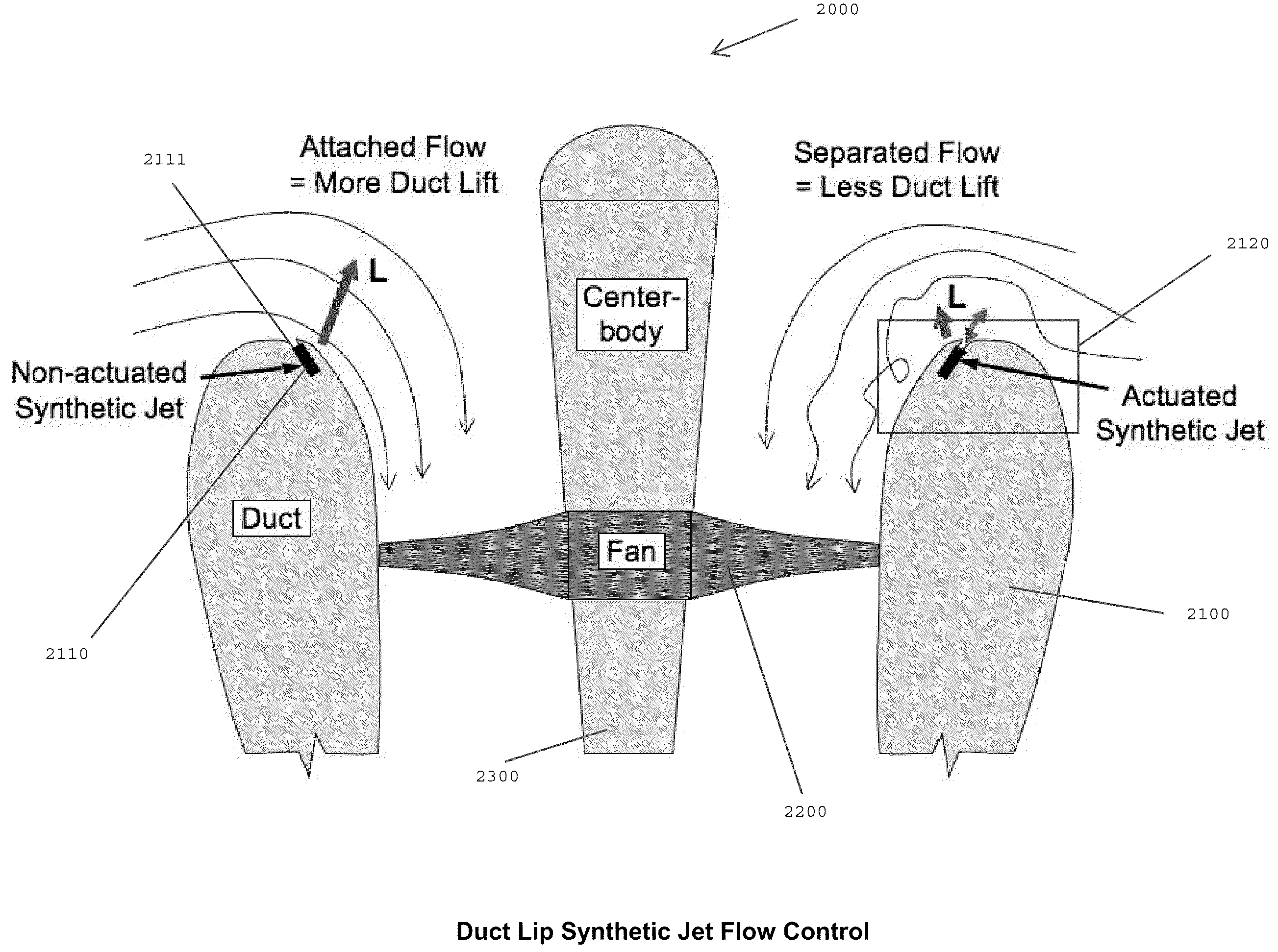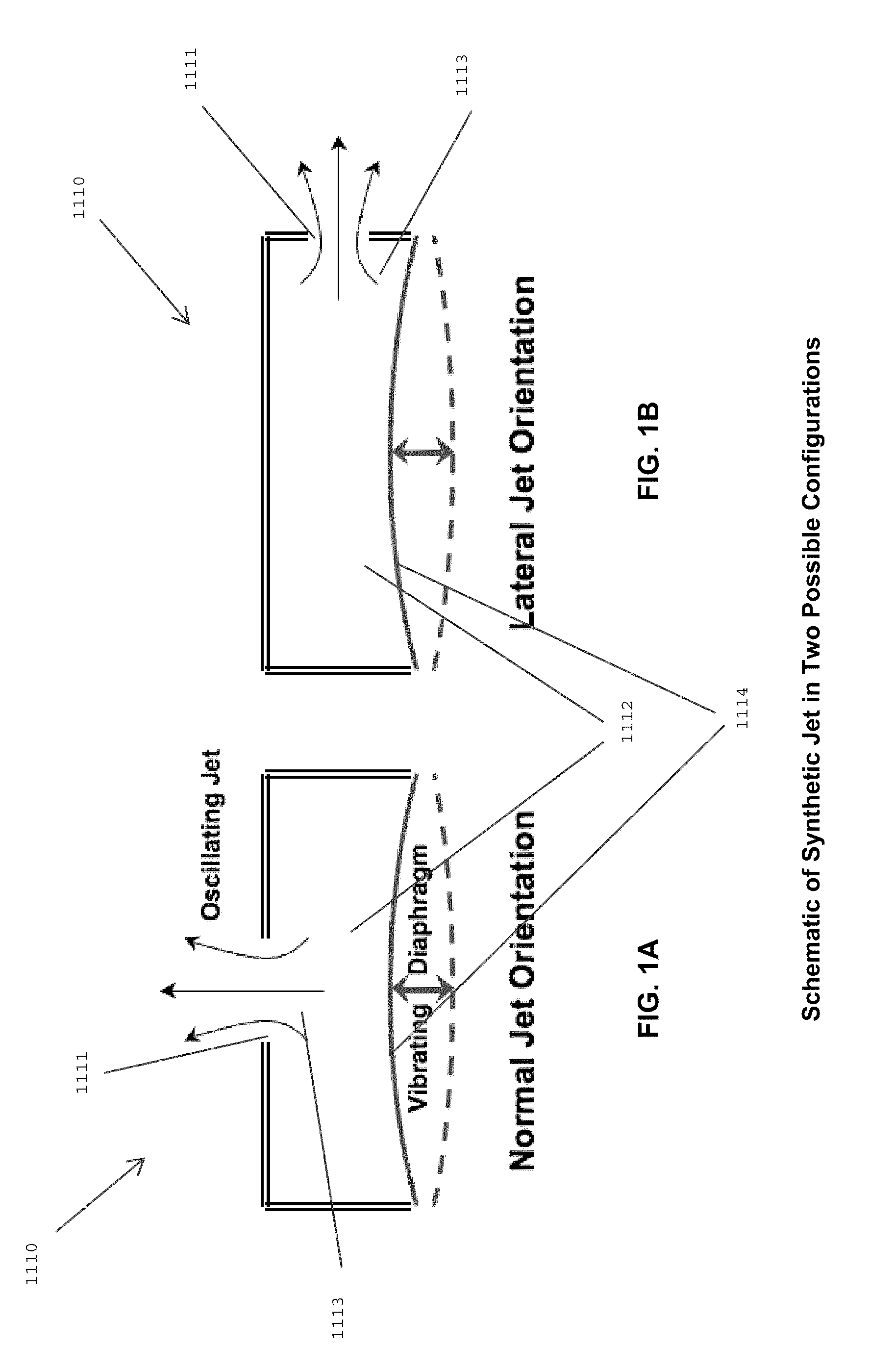Ducted Fans with Flow Control Synthetic Jet Actuators and Methods for Ducted Fan Force and Moment Control
a technology of synthetic jet actuators and ducted fans, applied in the field of aerodynamics, can solve the problems of complex problem, net force in thrust direction, production of lift and pitching moment, etc., and achieve the effect of enhancing vehicle performance and efficiency and reducing undesirable moments
- Summary
- Abstract
- Description
- Claims
- Application Information
AI Technical Summary
Benefits of technology
Problems solved by technology
Method used
Image
Examples
example i
Leading Edge Blowing Analysis
[0096]FIG. 8A-C provide a visual representation of a flow entering a ducted fan with respectively no blowing of jets, 100-ft / sec blowing, and 200-ft / sec blowing at the leading edge surface of a ducted fan. For these analyses, the blowing boundary condition was applied at the exit face of the slot. This reduced order modeling allowed for solution convergence. Comparing the 100-ft / sec and 200-ft / sec blowing with the no blowing case, FIGS. 8A-C show that leading-edge blowing separates the flow over the lip. When the blowing is not present, the flow proceeds into the duct smoothly. As blowing velocity is increased, the core of the separated region is lifted farther off the surface. Also, as blowing velocity is increased, the effect on the vehicle pitching moment is increased. The 50-ft / sec blowing velocity reduced the no blowing configuration pitching moment by more than a third, 100-ft / sec blowing reducing it by half, and 200-ft / sec blowing reducing the no-...
example ii
Coanda Trailing Edge Blowing Analysis
[0097]FIG. 9 shows a cross-sectional view of a duct, emphasizing trailing edge geometry of an embodiment of the invention. In this embodiment, a trailing edge geometry was developed for a 0.03 inch slot width and Coanda surface. In initial steadystate analyses, the jet velocity was imposed at the slot exit plane, i.e., the internal slot geometry was not modeled. In these cases, the internal orifice geometry was modeled with the sinusoidal velocity boundary condition applied at the beginning of the orifice neck. Steady blowing over the windward trailing edge at 200 ft / sec resulted in a normal force and decreased the pitching moment. Although the expansion of the streamtube resulted in an expected loss of thrust, power required by the fan also decreased.
[0098]Jet velocity was modeled as a time varying sinusoidal function. The 2400-Hz, ±200-ft / sec normal sinusoidal velocity boundary condition (values taken from bench test performance) was modeled ov...
example iii
Wind Tunnel Tests
[0101]Static (hover) tests were performed in a high bay area and wind tunnel tests were performed in the Virginia Tech 6 ft×6 ft Stability Wind Tunnel. The vehicle model was fabricated from machined aluminum and nylon as well as rapid prototyped resin parts. The model was supported by a 6-component force and moment balance in a side mount orientation to align the most sensitive channel of the balance with the vehicle's pitching moment axis (y-axis). Pitch sweeps were executed by rotating the wind tunnel turntable on which the balance is mounted, with the direction of flight in the positive x-direction (when angle of attack is zero).
[0102]FIG. 11 provides an illustration of the balance and vehicle used for the wind tunnel testing, along with the coordinate system used for collecting data. The data presented herein was transformed to move the moment reference center to the center of the duct lip as a simple datum for the vehicle design.
[0103]FIG. 12 illustrates this c...
PUM
 Login to View More
Login to View More Abstract
Description
Claims
Application Information
 Login to View More
Login to View More - R&D
- Intellectual Property
- Life Sciences
- Materials
- Tech Scout
- Unparalleled Data Quality
- Higher Quality Content
- 60% Fewer Hallucinations
Browse by: Latest US Patents, China's latest patents, Technical Efficacy Thesaurus, Application Domain, Technology Topic, Popular Technical Reports.
© 2025 PatSnap. All rights reserved.Legal|Privacy policy|Modern Slavery Act Transparency Statement|Sitemap|About US| Contact US: help@patsnap.com



